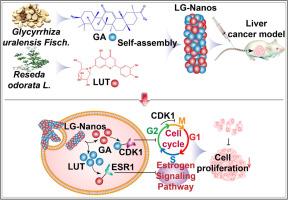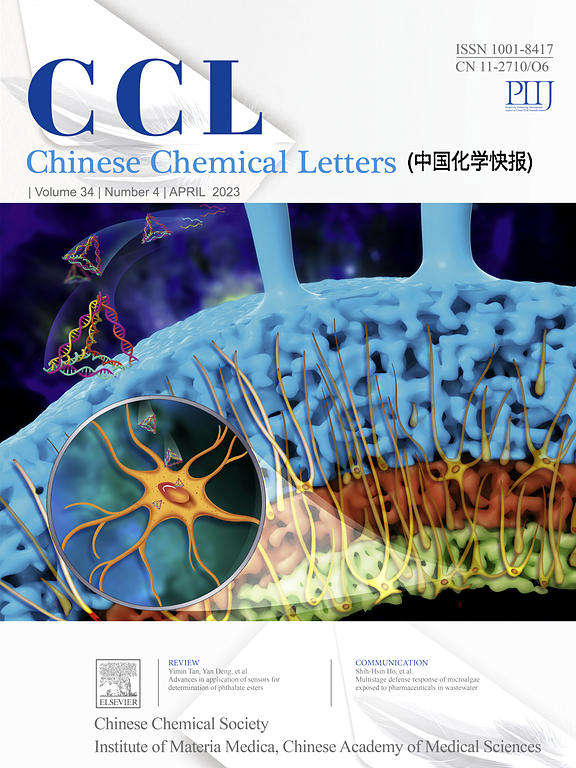木犀草素和甘草次素通过自组装成无载流子纳米结构,协同作用于肝癌
IF 8.9
1区 化学
Q1 CHEMISTRY, MULTIDISCIPLINARY
引用次数: 0
摘要
肝癌是癌症相关死亡的第四大原因,也是代偿性肝硬化患者死亡的主要原因。近年来,中医药在肝癌治疗中的作用越来越受到人们的关注和认可。木犀草素(lutein, LUT)和甘草次素(glycyrhetinic, GA)是从中草药中提取的天然化合物。LUT具有多种生物活性,包括抗炎、抗菌、抗病毒、抗肿瘤和神经保护作用。GA能明显抑制癌细胞的生长和转移。然而,这两种化合物的低水溶性阻碍了它们的临床应用。在本研究中,设计了由LUT和GA自组装的棒状纳米颗粒(NPs),以提高药物溶解度和肿瘤靶向能力。我们验证了NPs的组装机制是π-π堆叠。这些NPs显著抑制肝癌细胞的增殖,而对正常肝细胞无显著影响。在肝癌小鼠模型中,这些NPs由于其增强的渗透性和滞留作用以及GA对肝癌细胞的亲和力而表现出优越的肿瘤靶向能力,从而具有更好的治疗效果和更低的全身毒性。网络药理学分析结果显示,LUT和GA分别靶向雌激素受体1 (estrogen receptor 1, ESR1)蛋白和细胞周期蛋白依赖性激酶1 (cyclin-dependent kinase 1, CDK1)蛋白,共同诱导肿瘤细胞周期阻滞,从而抑制肿瘤细胞增殖。本研究为肝癌的治疗提供了新的参考。本文章由计算机程序翻译,如有差异,请以英文原文为准。

Luteolin and glycyrrhetinic exert cooperative effect on liver cancer by selfassembling into carrier-free nanostructures
Liver cancer is the fourth cause of cancer-related deaths and the primary cause of death in patients with compensated cirrhosis. In recent years, the role of traditional Chinese medicine in the treatment of liver cancer has attracted more and more attention and recognition. Luteolin (LUT) and glycyrrhetinic (GA) are natural compounds extracted from Chinese herbal medicine. LUT exhibits various biological activity including anti-inflammatory, antibacterial, antiviral, anti-tumor, and neuroprotective effects. GA significantly inhibits the growth and metastasis of cancer cells. However, the low water solubility of both compounds hinders their clinical applications. In this study, rod-shaped nanoparticles (NPs) self-assembled from LUT and GA were designed to enhance drug solubility and tumor-targeting capability. We verified that the assembly mechanism of the NPs was π-π stacking. These NPs significantly inhibited the proliferation of liver cancer cells while had no significant effect on normal liver cells. In a mouse model of liver cancer, these NPs demonstrated superior tumor-targeting ability due to the enhanced permeability and retention effect, and the affinity of GA for liver cancer cells, resulting in better therapeutic efficacy with lower systemic toxicity. Results of network pharmacology analysis showed that LUT and GA respectively targeted estrogen receptor 1 (ESR1) protein and cyclin-dependent kinase 1 (CDK1) protein to corporately induce tumor cell cycle arrest, which induced the inhibition of tumor cell proliferation. In conclusion, this study provides a novel reference for the treatment of liver cancer.
求助全文
通过发布文献求助,成功后即可免费获取论文全文。
去求助
来源期刊

Chinese Chemical Letters
化学-化学综合
CiteScore
14.10
自引率
15.40%
发文量
8969
审稿时长
1.6 months
期刊介绍:
Chinese Chemical Letters (CCL) (ISSN 1001-8417) was founded in July 1990. The journal publishes preliminary accounts in the whole field of chemistry, including inorganic chemistry, organic chemistry, analytical chemistry, physical chemistry, polymer chemistry, applied chemistry, etc.Chinese Chemical Letters does not accept articles previously published or scheduled to be published. To verify originality, your article may be checked by the originality detection service CrossCheck.
 求助内容:
求助内容: 应助结果提醒方式:
应助结果提醒方式:


